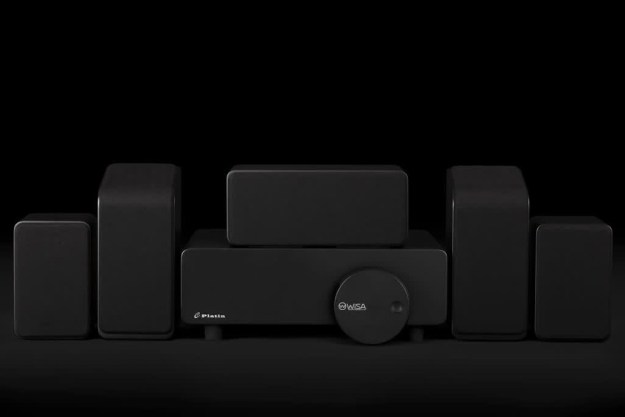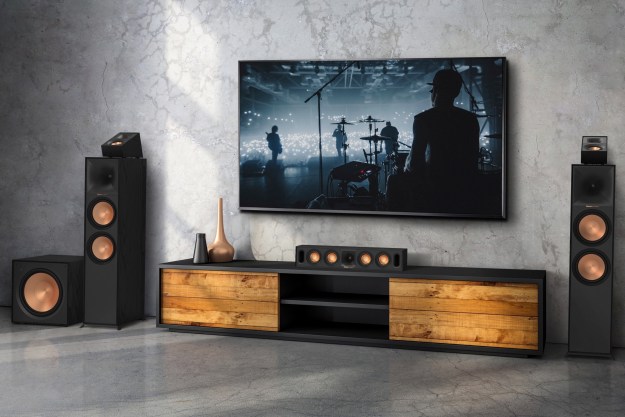For many of us, the Infinity brand brings back nostalgic memories of CD players (they were devices used to play CDs) feeding through smooth, accurate speakers with sleek designs and an accessible price point. Harman, the umbrella brand that owns Harman Kardon, JBL, Infinity, and others, is playing on our fond memories, reviving the Infinity brand with a brand new Reference series of home theater speakers. The lineup includes everything from floor standing towers, to subwoofers, for a total of nine speakers in all, ready to ship today.
R263 and R253 floorstanding loudspeakers ($1,100/$900 per pair)
Starting from the top down, Infinity’s new floor standing speakers are both three-way driver designs to cover the bass, midrange, and treble. Like all of the new Reference speakers, they incorporate Infinity’s Ceramic Metal Matrix Diaphragm (CMMD) woofers, sculpted in dual 6.5-inch and dual 5.25-inch sizes respectively. The CMMD design enlists aluminum cones between layers of a “durable ceramic surface” for a rigid, accurate frequency response that picks up the subtleties of the sound.
The towers also include Infinity’s flat-piston CMMD midrange drivers, designed to decrease distortion between the mid and high frequencies, and finally, both sets are topped off with a 1-inch CMMD tweeter, which are claimed to be “mated to an advanced waveguide” for seamless integration between the entire driver set for a full, balanced sound across all registers. The drivers for both models are enclosed in braced wood grain cabinets with dual rear ports for minimal low end resonance.
RC263 and RC253 center channel ($500/$350 per pair)
Infinity went all out for the RC263 center channel speaker, utilizing a very similar driver design as the tower speakers, though in a much smaller, closed cabinet. Drivers include dual 6.5-inch CMMD woofers, a single flat-piston CMMD midrange driver, and the waveguide controlled CMMD tweeter for a three-way configuration — something we’ve rarely seen in a center channel speaker. That’s a whole lot of power aimed at the center channel of your movies and surround mixes, and we expect this baby to sing.
The RC253 steps down slightly, utilizing dual 5.25-inch woofers, and the same 1-inch tweeter. However, the 253 loses the midrange flat-piston driver, which is touted as the key to clear and powerful vocals and dialogue delivered by its more expensive companion, which may make the RC263 a better choice, especially for those who watch a lot of movies.
R162 and R152 bookshelf speakers ($500/$400 MSRP per pair)
There isn’t a lot a lot to say about these guys. Each speaker is dropped into a single-ported braced cabinet, and topped with the series’ 1-inch CMMD aluminum tweeter. The R162 should pack a deep punch for a bookshelf thanks to its 6.5-inch CMMD woofer, while the R152’s smaller 5.25-inch woofer outlines a lighter sound. Digging into the specs backs that up, as the R162 reaches down to 49Hz at the low end, while the R152 tops out at 60Hz.
RS152 surround speaker ($500 MSRP per pair)
Like a lot of home theater series, the RS152 perhaps deviates the most from the rest of the family (aside from the subs, of course). The speaker is designed for wall mounting, and as such has some unique technology inside, the most compelling of which is its Hemispherical Soundfield Technology, which uses a combination of driver positioning and waveguide control for a “180 degree hemispherical listening area.” The design is intended to create a seamless dispersion of all frequencies across the back of your home theater room for a more consistent overall performance.
The speakers can be keyhole mounted, and include a 5.5-inch CMMD woofer, and dual 1-inch CMMD tweeters set at angles.
Sub R12 and Sub R10 ($600/$500 MSRP)
Finally, Infinity will bust out two new subwoofers for the series in 12-inch and 10-inch fiber-composite drivers. Both subs are powered by digital amplifiers, packing 300 and 200 watts of earth rumbling power, respectively. The subs come in ported cabinets, and offer controls for crossover, level, and a selectable low frequency output.
Capping a new era for the Infinity family, the new Reference series looks primed and ready to power up your home theater room. It should be noted that, although we’ve quoted the suggested price above, at last check many of the new speakers were available for a lower price on the Infinity website. If you’re in the market, take a peak at the site today and see if your ready to invite Infinity back into your home.
Editors' Recommendations
- Home theater receiver sale: Save on Yamaha, Sony, and more
- Don’t miss this huge sale on Yamaha home theater receivers
- You Asked: VR home theater, universal remotes, and Dolby Atmos music
- Dolby Atmos FlexConnect could eliminate home theater soundbars and HDMI cables
- The best XGIMI projectors for home theaters, parties, and more this holiday season


